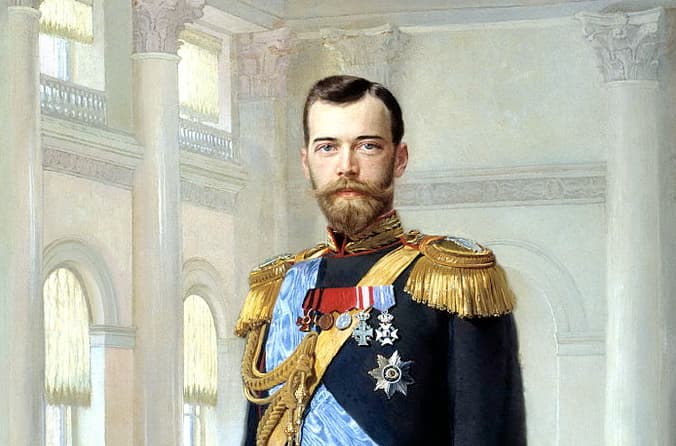For Russia, It’s 1916 All Over Again
The nation appears to be losing its grip as it did before the Bolshevik revolution.

Two blocks from the Hermitage Museum at St. Petersburg stands an opulent restaurant — “Year 1913.” Opened in the 1990s, it offers an extensive menu, from Baltic herring to Siberian dumplings. An American visitor once asked the maître d’: “Why the name?” He responded sourly: “It was the last good year.”
Today, as Russia’s battlefield casualties soar in Ukraine, many Russians sense the nation again is watching a regime lose its grip. Essayists hark back to the dark days of World War I, when battlefield failures and bread riots combined to topple Tsar Nicholas II from the gold and silver throne that the Romanovs occupied for three centuries.
“Putin repeats not so much Stalin as Nicholas II,” a former speechwriter for the Russian president, Abbas Gallamov, writes in an essay for Russian blog site Publizist. “Everything looks as if Russia finds itself in a time period with the same political logic as in 1916.”
In a big psychological blow, two unidentified drones flew over the Kremlin walls early Wednesday morning. Videos show one drone hitting the roof of an 18th-century palace, causing an explosion. It hit precisely behind the Red Square reviewing stand where Mr. Putin is to review troops Tuesday. Shortly after the drone attack, the mayor of Moscow, Sergei Sobyanin, closed the city’s airspace to unauthorized drone flights.
“If we presume it was a Ukrainian attack, consider it a performative strike, a demonstration of capability and a declaration of intent: ‘don’t think Moscow is safe,’” a Russia security analyst, Mark Galeotti, writes on Twitter.
More concerning is the tattered physical condition of the military that Mr. Putin will review at a parade celebrating the Soviet Union’s victory in 1945 over Nazi Germany. Since invading Ukraine 14 months ago, Russia has lost as many as 250,000 killed and wounded soldiers, the chairman of America’s Joint Chiefs of Staff, General Milley, estimates this week in Foreign Affairs.
This would be one third of Russia’s peacetime military. Of these, 100,000 were killed or wounded over the last five months, the White House National Security spokesman, John Kirby, told reporters Monday.
By comparison, the Soviet Union, with twice the population of today’s Russia, lost 68,206 killed and wounded during its decade-long war in Afghanistan, according to the book “The Soviet-Afghan War: Breaking the Hammer & Sickle.”
According to the Ukrainian military’s official tally, Russia also has lost 308 fighter bombers, 3,701 tanks and 7,193 armored personnel carriers. This is at least one half of Russia’s mobile armor. Russia has not won a battle since July.
“Russia is on the brink of catastrophe,” Wagner mercenary group leader Yevgeny Prigozhin told a pro-war Russian military blogger last week. “We’ve turned the Russian army — the second army in the world — into what? … What kind of army are we if we couldn’t even manage itty bitty Ukraine?” Ukrainian casualties are believed to be about one-third of Russia’s.
Taking a cue from the Romanovs, Mr. Prigozhin and another nationalist leader, Igor Girkin, are creating modern day equivalents of the Black Hundreds. Active until the 1917 Revolution, these ultranationalist groups pursued — with screeds in the press and violence in the street — Russo-centric, anti-Jewish, and anti-Ukrainian doctrines. Conservative government officials supported the Black Hundreds to back the Czar and the government’s pro-war faction.
Another Publizist blogger, Pavel Pryanikov, cites similarities between the Black Hundreds and the Angry Patriots Club, a group that Girkin formed last month. The Club’s slogans are: “Everything for the front, everything for the Victory, glory to Russia!” Mr. Pryanikov writes: “I read the manifesto of the Angry Patriots. Point for point, it recalls the speeches of the Black Hundreds in 1915-1916.”
Fearing a Kremlin capitulation, today’s groups want to bolster the pro-war faction in Russia’s government, contends the Institute for the Study of War. This Washington-based think tank writes: “Members of the Club stated that Russia will imminently face defeat in Ukraine and may experience a pro-Western coup or civil war if Moscow does not drastically improve the situation on the frontlines.”
Meanwhile, Mr. Putin retreats more and more into his bunker. His last trip outside the country was six months ago, to neighboring Belarus, a client state. Over the same time, President Zelensky has made 10 foreign trips, to America, Britain, France, Belgium, Poland (three times), Finland, and the Netherlands. Thursday, at the Hague, Mr. Zelensky called for a special tribunal to judge Russia’s invasion.
In March, the International Criminal Court, a permanent war crimes court based at the Hague, issued an arrest warrant for Mr. Putin for the suspected deportation of children from Ukraine. In August, the leaders of Brazil, China, India, Russia, and South Africa are to gather at Durban for a summit. Now, South African officials tell reporters it would be better if Mr. Putin participated by Zoom.
Inside Russia, a new book, “The End of the Regime: How Three European Dictatorships Ended,” has gone through four Russian language editions since it came out in January. Russians are reading how three rightwing dictatorships — in Spain, Portugal and Greece — became democracies.
A Carnegie Endowment fellow, Alexander Baunov, wrote of his book last week in the New York Times: “The book has become a pretext for discussion of taboo topics, such as political transition, the health and death of the leader, defeat in a colonial war, the end of isolation and, indeed, the end of the regime.”
For Russia, some journalists find insights in the chaos caused by World War I. Nezavisimaya Gazeta’s editors call Mr. Putin’s 2022 invasion of Ukraine “a turning point in Russian history,” rivaling 1917. A former CIA analyst of the Soviet Union, Paul A. Goble, summarizes a Moscow Times article on a spate of local protests over utility rate hikes: “Will Regional Protests about Utility Bills Be Like 1917 Petrograd Bread Riots that Led to Revolution?”

